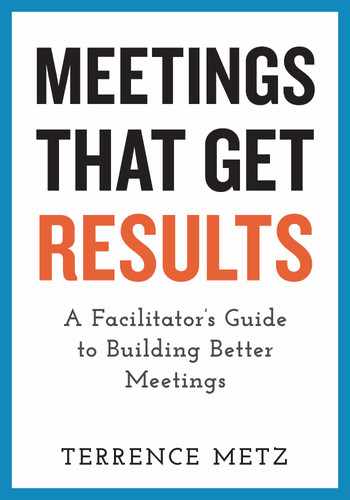This practical, comprehensive guide to designing and running more effective meetings will result in less time wasted, more collaborative decision-making, and measurably improved business outcomes.
There's nothing more frustrating than an unproductive meeting—except when it leads to another unproductive meeting. Yet every day millions of people conduct meetings—in person or online—without the critical understanding or formal training on how to plan and lead them effectively. This book offers a structured method to ensure that meetings will produce clear and actionable results. Meetings that are profitable and productive ultimately lead to fewer meetings. This book offers leaders a significant edge by
• Empowering readers to help their groups create, innovate, and break through the barriers of miscommunication, politics, and intolerance
• Making it easier for them to help others forge consensus and shared understanding
• Providing them with proven agenda steps, tools, and detailed procedures
Readers will learn how to resolve or manage common problems, inspire creativity, and transfer ownership to their meeting participants while managing interpersonal conflicts and other disruptions that arise. In a world of back-to-back meetings, this book explains the how-to details behind game-changing tools and techniques.
Table of Contents
- Cover
- Title Page
- Copyright Page
- Dedication
- Contents
- Foreword
- Introduction Launching: Let’s Get Started
- 1 Serving: Discipline of Servant Leadership
- 2 Leading: Be a Servant, Not a Senator
- 3 Facilitating: Making It Easier with Three Core Skills
- Three Core Skills of Meeting Leaders
- The Core Skill of Speaking Clearly
- Rhetorical Precision: Why It Can Be Tricky
- Substance over Style
- Zen of the Experience
- Which Path? The Art of Questioning
- The Core Skill of Active Listening
- Facilitation Power: Observing
- The Core Skill and Discipline of Remaining Neutral
- Quick Summary on Facilitating
- 4 Collaborating: How You Can Manage Conflict
- The Ways People Think
- Evidence: Smart People Make Dumb Decisions
- “Politikos”: The Science of People
- Groups Evolve, Then Regress
- Facilitating Multiple Generations at the Same Time
- Situational Causes of Conflict
- Paradigm Challenges
- Conflict as Challenge and Opportunity
- Anger and Some Other Stuff
- Quick Summary on Collaborating
- 5 Structuring: Meeting Design Made Easy
- Two Types of Agendas
- Launch (Introduction) Agenda Step
- Icebreakers Tool
- Other Considerations
- Review and Wrap (Conclusion) Agenda Step
- Review and Wrap Activity 1: Review Deliverable
- Review and Wrap Activity 2: Manage Open Issues Using the Parking Lot Tool
- Review and Wrap Activity 3: Create a Communications Plan
- Review and Wrap Activity 4: Assessment Tool, with Four Options
- Structuring with Mindful Conversations
- Annotated Agenda Development
- Meeting or Workshop?
- Three Meeting Approaches
- Quick Summary on Structuring
- 6 Planning Approach for Any Group: Who Does What, by When?
- For Strategies, Initiatives, Projects, Products, and Teams
- Explanation by Analogy
- Pre-session Survey or Online Poll—for Strategic Planning Only
- 1. Launch (Introduction) Agenda Step
- 2. Mission or Charter (Why Are We Here?)
- Brainstorming Tool
- Breakout Teams Tool
- Coat of Arms Tool
- 3. Values (Who Are We?)
- Categorizing Tool
- 4. Vision (Where Are We Going? How Do We Know If We Got There or Not?)
- Temporal Shift Tool
- 5. Key Measures Agenda Step and Tool (What Are the CTQs, KPIs, and OKRs?)
- Definition Tool
- 6. Quantitative TO-WS Analysis Agenda Step (What Is Our Current Situation?)
- Quantitative TO-WS Analysis Tool: Current Situation or Situation Analysis
- 7. Actions Agenda Step (What Are We Going to Do to Reach Our Measures?)
- Actions Tool
- 8. Alignment Agenda Step (Is This the Right Stuff?)
- Alignment Tool
- 9. Responsibility Matrix (Who Does What by When?)
- Roles and Responsibilities Tool
- 10. Communications Plan (What Do We Agree to Tell Others?)
- Communications Plan Tool
- 11. Review and Wrap (Conclusion) Agenda Step
- Quick Summary on Planning
- 7 Deciding about Anything Approach: Agree on the Why Before the What
- Decision-Making Options
- Voting Sucks
- Three Requirements for Any Decision
- Two Scenarios
- 1. Launch (Introduction) Agenda Step
- 2. Purpose of the Object
- Purpose Tool
- Clarifying Tool
- 3. Options (for the Object)
- 4. Decision Criteria (for the Object)
- 5. Deselecting and Decision
- PowerBalls Tool
- Bookend Rhetoric Tool
- Decision Matrix Tool
- Scorecard Tool
- Weighting
- Perceptual Mapping Tool
- Real-Win-Worth Tool
- 6. Testing (Decision Quality)
- Decision Quality Tool
- 7. Review and Wrap (Conclusion) Agenda Step
- Quick Summary on Decision-Making
- 8 Creative Problem-Solving Approach: Managing More Than One Right Answer
- Problem Definition
- 1. Launch (Introduction) Agenda Step
- 2. Purpose of the Cybersecurity Department (Future State)
- Creativity Tool
- 3. Problem State (“Burnout”)
- Force Field Analysis Tool
- 4. Symptoms
- Perspectives Tool
- Thinking Hats Tool
- 5. Causes
- Root Cause Analysis Tool
- After-Action Review Tool
- 6. Actions (Solutions)
- Innovation Warm-Ups Tool
- Scamper Tool
- 7. Testing (Solution Quality)
- Scenarios and Ranges Tool
- 8. Review and Wrap (Conclusion) Agenda Step
- Quick Summary on Problem Solving
- 9 Controlling: Online Challenges and Special Situation Tools
- Epilogue
- Appendix Support and Reinforcement
- Glossary
- Bibliography
- Acknowledgments
- Index
- About the Author
